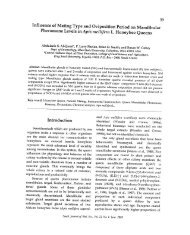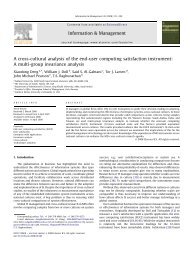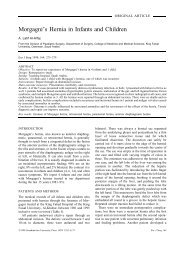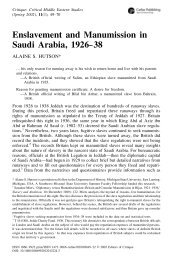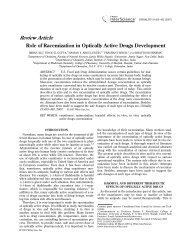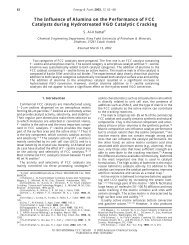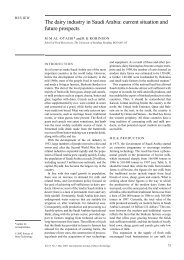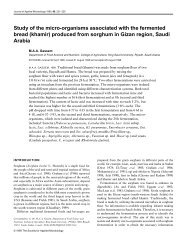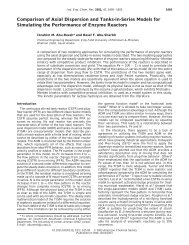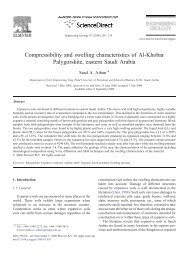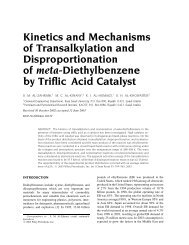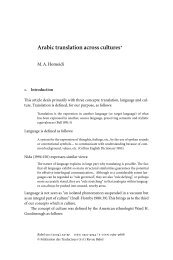Post-natal Development in the Linear and Tric Morphometrics of the ...
Post-natal Development in the Linear and Tric Morphometrics of the ...
Post-natal Development in the Linear and Tric Morphometrics of the ...
Create successful ePaper yourself
Turn your PDF publications into a flip-book with our unique Google optimized e-Paper software.
<strong>Post</strong>-<strong>natal</strong> <strong>Development</strong> <strong>of</strong> <strong>the</strong> Camelidae Skull 233<br />
Fig.1. Measurments <strong>of</strong> <strong>the</strong> camel skull (dorsal view): <strong>in</strong>ion (I), nasion<br />
(N), prosthion (P), zygion (Z), skull length (1), cranial length (2)<br />
viscerocranial length (3), maximum width <strong>of</strong> neurocranium (4) <strong>and</strong><br />
maximum zygomatic width (5).<br />
100/cranial length), facial <strong>in</strong>dex (maximum zygomatic width<br />
100/viscerocranial length), cranial volume <strong>and</strong> skull weight.<br />
The measurement <strong>of</strong> <strong>the</strong> cranial volume was commenced by<br />
plugg<strong>in</strong>g <strong>the</strong> foram<strong>in</strong>a open<strong>in</strong>g <strong>in</strong>to <strong>the</strong> cranial cavity with<br />
fresh Plastic<strong>in</strong>e.The cavity was <strong>the</strong>n filled with f<strong>in</strong>e-quality rice<br />
seeds to <strong>the</strong> level <strong>of</strong> <strong>the</strong> distal border <strong>of</strong> <strong>the</strong> foramen magnum.<br />
When <strong>the</strong> cranial cavity was filled with rice seeds via <strong>the</strong><br />
foramen magnum, <strong>the</strong> space immediately cranial to <strong>the</strong><br />
tentorium cerebelli osseum was also filled.The contents were<br />
emptied <strong>and</strong> measured <strong>in</strong> a measur<strong>in</strong>g cyl<strong>in</strong>der calibrated <strong>in</strong><br />
millilitres.<br />
L<strong>in</strong>ear <strong>and</strong> angular dimensions <strong>of</strong> <strong>the</strong> cranial base (Fig 3)<br />
The cranial base, as traditionally def<strong>in</strong>ed <strong>in</strong> growth studies <strong>of</strong><br />
<strong>the</strong> mammalian skull, consists (<strong>in</strong> <strong>the</strong> median plane) <strong>of</strong> a<br />
segment, termed <strong>the</strong> basicranial axis, stretch<strong>in</strong>g from <strong>the</strong><br />
pituitary region to <strong>the</strong> ventral (anterior) marg<strong>in</strong> <strong>of</strong> <strong>the</strong> foramen<br />
magnum, an anterior extension from <strong>the</strong> pituitary region to <strong>the</strong><br />
junction <strong>of</strong> <strong>the</strong> frontal <strong>and</strong> nasal bones, <strong>and</strong> a posterior<br />
extension from <strong>the</strong> ventral to <strong>the</strong> dorsal marg<strong>in</strong> <strong>of</strong> <strong>the</strong> foramen<br />
magnum (Moore, 1981).<br />
Fig.2. Measurments <strong>of</strong> <strong>the</strong> camel skull (lateral view): <strong>in</strong>ion (I),<br />
prosthion (p), nasion (N), skull length (1), viscerocranial length (2) <strong>and</strong><br />
cranial length (3).<br />
Fig.3. Sagittal sections <strong>of</strong> <strong>the</strong> skull <strong>of</strong> camel to show l<strong>in</strong>ear <strong>and</strong><br />
angular dimensions <strong>of</strong> cranial base.E ¼ endobasion; N ¼ nasion; O ¼<br />
opisthion; PP ¼ pituitarty po<strong>in</strong>t.The anterior <strong>and</strong> posterior basicranial<br />
angles are shown by dashed l<strong>in</strong>es.<br />
Statistical analysis<br />
Changes <strong>in</strong> <strong>the</strong> craniometric measurements with<strong>in</strong> <strong>and</strong> between<br />
age groups were statistically evaluated by <strong>the</strong> least-squares<br />
analysis <strong>of</strong> variance us<strong>in</strong>g <strong>the</strong> GLM procedures <strong>of</strong> <strong>the</strong><br />
statistical analysis system (SAS, 1996).<br />
Results<br />
The craniometric measurements <strong>and</strong> <strong>the</strong> cranial volume<br />
<strong>in</strong>creased significantly with age.The results recorded <strong>in</strong> Table<br />
1 reveal that <strong>the</strong> skull, cranial <strong>and</strong> viscerocranial lengths,<br />
neurocranium <strong>and</strong> <strong>the</strong> maximum zygomatic widths, <strong>in</strong>creased<br />
significantly with age.Although <strong>the</strong> skull <strong>and</strong> facial <strong>in</strong>dices<br />
<strong>in</strong>creased, <strong>the</strong> cranial <strong>in</strong>dex <strong>in</strong>significantly decreased <strong>in</strong> value<br />
with age.<br />
The results <strong>of</strong> <strong>the</strong> correlation analyses <strong>of</strong> <strong>the</strong> features<br />
exam<strong>in</strong>ed <strong>in</strong> <strong>the</strong> immature <strong>and</strong> mature animals are recorded <strong>in</strong><br />
Table 2.<br />
There was a strongly positive correlation among <strong>the</strong> skull,<br />
viscerocranial lengths, cranial <strong>and</strong> <strong>the</strong> maximum zygomatic<br />
width <strong>in</strong> <strong>the</strong> immature <strong>and</strong> mature animals.<br />
The maximum width <strong>of</strong> <strong>the</strong> neurocranium showed a strong<br />
significant positive correlation with all <strong>of</strong> <strong>the</strong> measurements <strong>in</strong><br />
both <strong>the</strong> immature <strong>and</strong> mature groups <strong>of</strong> camels.<br />
The skull <strong>and</strong> facial <strong>in</strong>dices <strong>in</strong> <strong>the</strong> immature <strong>and</strong> mature<br />
camels were found to have a positive correlation with <strong>the</strong><br />
maximum zygomatic width <strong>and</strong> <strong>the</strong> skull, cranial <strong>and</strong> viscerocranial<br />
lengths <strong>in</strong> <strong>the</strong> immature <strong>and</strong> mature animals.The<br />
cranial <strong>in</strong>dex was found to have a negative correlation with all<br />
<strong>of</strong> <strong>the</strong> craniometric measurements with <strong>the</strong> exception <strong>of</strong> <strong>the</strong><br />
viscerocranial length, which was <strong>in</strong>significantly positive.<br />
However, a similar comparison <strong>in</strong> <strong>the</strong> immature <strong>and</strong> mature<br />
groups <strong>of</strong> camels showed that <strong>the</strong> cranial <strong>in</strong>dex had a weak<br />
negative significant correlation with <strong>the</strong> cranial length.<br />
A positive correlation between <strong>the</strong> facial <strong>in</strong>dex <strong>and</strong> <strong>the</strong><br />
maximum width <strong>of</strong> <strong>the</strong> neurocranium was found <strong>in</strong> <strong>the</strong><br />
immature <strong>and</strong> mature camels.<br />
The correlation between <strong>the</strong> skull <strong>and</strong> facial <strong>in</strong>dices <strong>in</strong> both<br />
groups was positive <strong>and</strong> strong.The correlation between <strong>the</strong><br />
cranial <strong>and</strong> facial <strong>in</strong>dices was weakly significant <strong>in</strong> <strong>the</strong><br />
immature <strong>and</strong> mature camels.



